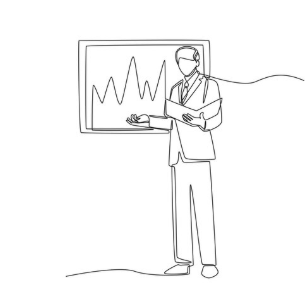Don’t trade like Rambo. Learn why fast decision-making in trading requires experience, practice, and a calm mind—not heroic instincts.
Have you ever watched a seasoned trader fire off buy and sell orders with machine-like speed and thought, “Wow, I wish I could think on my feet like that”? If you’re a stock market learner in India—maybe balancing a day job, family, and late-night chart watching—this kind of speed and sharpness might seem like a superpower.

But here’s the truth: thinking on your feet in trading isn’t magic. It’s muscle memory—earned, not born. Fast trading decisions aren’t about being Rambo in the markets. They’re about preparation, emotional discipline, and deliberate practice.
Let’s break the myth of spontaneous trading genius and help you build the real skills that make fast decision-making possible under pressure.
💣 Why We Think We Can Be Rambo in the Markets
We all love a good action movie. Rambo fights ten enemies alone, dives out of explosions, and makes lightning-quick decisions without blinking. But here’s the thing: trading is not war, and you’re not Rambo.
In real life, our brains aren’t wired to calmly evaluate risk during stress. The human body responds to danger with fight or flight—a primitive response designed for wild animals, not candlestick charts.
👎 Common Trading Rambo Mistakes:
- Chasing sudden spikes without a plan
- Adding to losing trades emotionally
- Reacting to news without analysis
- Removing stop-losses mid-trade
- Overtrading due to FOMO
These aren’t decisions. They’re reactions.
🧠 The Science: Fight-or-Flight Doesn’t Help in Trading
When you’re under pressure, your amygdala (the part of the brain responsible for fear) hijacks rational thinking. Your prefrontal cortex—the logical decision-maker—gets overridden. That’s why under stress, people:
- Panic sell on a dip
- Freeze during volatility
- Exit early from a winning trade
- Hold a loser too long, hoping
You may feel like you’re thinking on your feet, but you’re actually losing your edge.
🛠️ Instincts Can Be Trained—But Only Through Repetition
You don’t cross a busy Indian street based on pure gut feel. You look both ways, assess vehicle speed, and anticipate other people’s moves. That’s experience.
Trading is no different.
Fast, intuitive decisions come only after:
- Hundreds of screen hours
- Reviewing your mistakes
- Structured practice in simulated environments
- Following a clear trading plan
🧘♂️ Key Insight:
You can’t “wing it” under stress. You can only fall back on what you’ve rehearsed.
📈 Trading Like a Seasoned Athlete: The Secret Sauce
Imagine Virat Kohli hitting a fastball. His swing is instinctive—but it wasn’t always. Years of practice built that reflex.
Similarly, successful traders build:
- Muscle memory for market setups
- Conditioned responses to volatility
- Risk controls they follow automatically
- Routines to avoid panic and overreaction
Trading is not about performing stunts. It’s about following systems.
📋 Why a Trading Plan is Better Than a Hero Complex
✍️ What Every Good Plan Covers:
- Entry and exit points
- Trade size and capital allocation
- Maximum risk per trade
- Emergency exit triggers (rate hikes, news)
- Clear “do not trade” zones (after losses, during fatigue)
🔑 When you plan, you reduce the need to make emotional decisions.
⚠️ The Invisible Training Behind Fast Traders
You see the “Rambo move” when a trader nails a setup live. What you don’t see is:
- The backtests done over months
- The losses they took learning
- The journals filled with patterns and feedback
- The disciplined waiting between setups
Like a magician, their trick is the illusion of spontaneity. But behind the scenes, it’s all repetition.
💬 Desi Example: Don’t Cross the Road Blindfolded
Let’s say you’re in Mumbai traffic, trying to cross a chaotic intersection. You wouldn’t just close your eyes and run. You’d scan both sides, watch driver behavior, and wait for the right gap. Over time, you get faster at doing this—not because you became brave, but because you became trained.
Trading is like crossing the road. Get reckless, and you’ll get hit. Wait, plan, and practice—and you’ll move swiftly and safely.
💡🧠 What You Should Remember
- Don’t trade like Rambo. Fast instincts are earned through slow repetition.
- Fight or flight hurts performance. Stress reduces smart thinking.
- Planning beats panic. Have a checklist before every trade.
- Risk management is your shield. You’re not invincible.
- Your “instinct” is just practiced behavior. Build it.
🚀 Actionable Steps to Trade Smarter (Not Faster)
✅ Step-by-Step for Beginners:
- Start slow. Trade 1 setup only.
- Journal every trade. What worked, what didn’t.
- Simulate under pressure. Use demo accounts during news events.
- Build rules. Make decisions before the market opens.
- Review after market. Treat every trade like a class.
🎯 Tip: When in doubt, sit out. Not trading is a decision too.
🎯 Final Thoughts: Rambo Might Win on Screen—You Win by Planning
In trading, speed without preparation is danger. Don’t aim for quick reflexes. Aim for trained reflexes.
The real edge? Staying calm, thinking clearly, and executing a well-planned strategy—even under stress.
So the next time you want to act like Rambo in the market, pause.
Be the calm one in chaos. The prepared one in pressure.
That’s how you trade like a pro.
📣 Call to Action:
Have you ever made a trade you thought was intuitive but later realized was emotional? Share your story in the comments or tag a fellow trader who needs to slow down before speeding up.

Why do I freeze during volatile markets?
Your brain triggers fight or flight, blocking logic. It’s natural without practice.
How can I train myself to make better fast decisions?
Through repetition, journaling, and trade simulations. Instincts are built.
Is intuition in trading reliable?
Only if it’s based on experience. Untrained gut instincts are risky.
What’s the best way to avoid panic trades?
Have a detailed plan. Follow a checklist. Breathe before reacting.
Can beginners ever think quickly in trading?
Yes—but only after structured practice, not overnight.